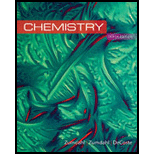
Concept explainers
Arrange the following substances in order of increasing mass percent of carbon.
a. caffeine. C8H10N4O2
b. sucrose, C12H22O11
c. ethanol, C2H5OH
Interpretation: The compounds
Concept introduction: The atomic mass is defined as the sum of number of protons and number of neutrons.
Molar mass of a substance is defined as the mass of the substance in gram of one mole of that compound.
The molar mass of any compound can be calculated by adding of atomic weight of individual atoms present in it.
To determine: The arrangement of compounds
Answer to Problem 78E
The increasing order of mass percent of carbon for the compounds
Explanation of Solution
To determine: The percentage composition (by mass) of carbon in the compound
The atomic weight of oxygen
The atomic weight of hydrogen
The atomic weight of nitrogen
The molar mass is the sum of mass of individual atoms present in it. Hence, molar mass of
Formula
The mass percent of element is calculated as,
Substitute the values of mass of carbon and molar mass of
The percentage composition (by mass) of carbon in
The atomic weight of carbon
To determine: The percentage composition (by mass) of carbon in compound
The atomic weight of carbon
The atomic weight of oxygen
The atomic weight of hydrogen
The molar mass is the sum of mass of individual atoms present in it. Hence, molar mass of
Formula
The mass percent of element is calculated as,
Substitute the values of mass of carbon and molar mass of
To determine: The percentage composition (by mass) of carbon in compound
The atomic weight of carbon
The atomic weight of oxygen
The atomic weight of hydrogen
The molar mass is the sum of mass of individual atoms present in it. Hence, molar mass of
Formula
The mass percent of element is calculated as,
Substitute the values of mass of carbon and molar mass of
To determine: The increasing order of mass percent of carbon for the compounds
The mass percent of carbon atom in
The mass percent of carbon atom in
The mass percent of carbon atom in
Hence, the increasing order of mass percent of carbon for the compounds
The percentage composition of any element is calculated by dividing the total mass of that element with molar mass of compound.
Want to see more full solutions like this?
Chapter 3 Solutions
Bundle: Chemistry, Loose-leaf Version, 10th + Enhanced Webassign Printed Access Card For Chemistry, Multi-term Courses
- Speaking of composite materials, indicate the correct option:(A). Composite materials can only be: metal-polymer or polymer-polymer.(B). Composite materials can be made up of particles, but not fibers or sheets.(C). When the reinforcing particles are uniformly distributed in a composite material, there may be a greater tendency for it to have isotropic properties.(D). None of the above is correct.arrow_forwardIf we are talking about viscoelastic modulus or viscoelastic relaxation modulus in polymers, indicate the correct option.(A). It reports the variation of elastic behavior as a function of time.(B). It is only useful for defining its glass transition temperature.(C). It only allows us to define the polymer degradation temperature.(D). Neither option is correct.arrow_forwardWhen natural light falls perpendicularly on a material A, it has a reflectivity of 0.813%. Indicate the value of the refractive index.arrow_forward
- In piezoelectricity and piezoelectric ceramics, one of the following options is false:(A). Piezoelectricity allows an electrical signal to be transformed into a mechanical one.(B). PbZrO3 is a well-known piezoelectric ceramic.(C). Piezoelectricity and ferroelectricity in general have no relationship.(D). One of the applications of piezoelectricity is sonar.arrow_forward(30 MARKS) Give the major product(s ) formed including relevant stereochemistry or the complete reaction conditions for the following reactions. More than one step may be required for each reaction arrow, in which case the steps must be numbered 1), 2) etc. (2 marks each box) h) i) h) OH i) HO H3PO4, heat 2 Brarrow_forwardNonearrow_forward
- Indicate which option is false(A). Resistivity has a residual component and a thermal component.(B). In some materials resistivity increases with T and in others it decreases.(C). In insulating materials, resistivity is very low.arrow_forwardIn ceramic materials, in relation to polymorphism, the same substance crystallizes differently when external conditions vary. Is this correct?arrow_forwardIndicate the type of bond that is considered to be a hydrogen bond.(A). Permanent dipole-dipole interaction between polar molecules.(B). Mixed ionic-covalent bond.(C). Principal interatomic bond(D). Van del Waals forces.arrow_forward
- Retro aldol: NaOH H₂O H NaOH & d H₂O Harrow_forwardDraw the product of the reaction shown below. Ignore inorganic byproducts. H conc. HBr Drawing Qarrow_forwardCalculate the atomic packing factor of diamond knowing that the number of Si atoms per cm3 is 2.66·1022 and that the atomic radii of silicon and oxygen are, respectively, 0.038 and 0.117 nm.arrow_forward
 Chemistry & Chemical ReactivityChemistryISBN:9781133949640Author:John C. Kotz, Paul M. Treichel, John Townsend, David TreichelPublisher:Cengage Learning
Chemistry & Chemical ReactivityChemistryISBN:9781133949640Author:John C. Kotz, Paul M. Treichel, John Townsend, David TreichelPublisher:Cengage Learning Chemistry by OpenStax (2015-05-04)ChemistryISBN:9781938168390Author:Klaus Theopold, Richard H Langley, Paul Flowers, William R. Robinson, Mark BlaserPublisher:OpenStax
Chemistry by OpenStax (2015-05-04)ChemistryISBN:9781938168390Author:Klaus Theopold, Richard H Langley, Paul Flowers, William R. Robinson, Mark BlaserPublisher:OpenStax ChemistryChemistryISBN:9781305957404Author:Steven S. Zumdahl, Susan A. Zumdahl, Donald J. DeCostePublisher:Cengage Learning
ChemistryChemistryISBN:9781305957404Author:Steven S. Zumdahl, Susan A. Zumdahl, Donald J. DeCostePublisher:Cengage Learning Chemistry: An Atoms First ApproachChemistryISBN:9781305079243Author:Steven S. Zumdahl, Susan A. ZumdahlPublisher:Cengage Learning
Chemistry: An Atoms First ApproachChemistryISBN:9781305079243Author:Steven S. Zumdahl, Susan A. ZumdahlPublisher:Cengage Learning
 Chemistry: The Molecular ScienceChemistryISBN:9781285199047Author:John W. Moore, Conrad L. StanitskiPublisher:Cengage Learning
Chemistry: The Molecular ScienceChemistryISBN:9781285199047Author:John W. Moore, Conrad L. StanitskiPublisher:Cengage Learning





